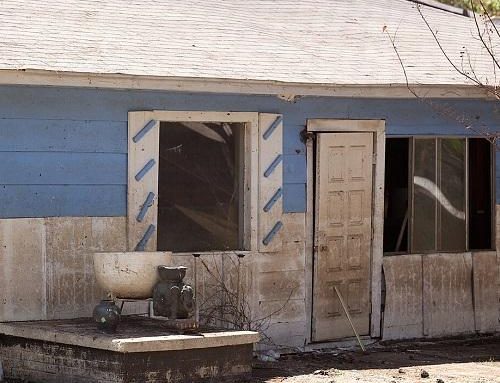PERU.
A strip of land with 1200 miles of sea coast, without a natural harbor, and 200 to 300 miles wide, consisting of a plain, mountains, a plateau, and still another range of mountains—this is Peru.
In the west, where the rain never falls, are numerous small rivers, to-day mountain torrents, to-morrow dry, rocky beds.
Between the lofty ranges of snow mountains is the highest plateau in the world, after Thibet. The southern part of this plateau is dry and desolate, the northern portion is well watered, with beautiful streams running now through deep cañons and then through rich, fertile valleys steadily descending toward the northeast; the valleys growing ever broader, warmer and more delightful, until the montaña is reached, only a few hundred feet above the Atlantic, where the streams have become rivers, navigable to the ocean.
The western slope of the mountains is dry and barren, so that breadstuffs and provisions are imported from Ecuador on the north, or from lower Chili, far to the south. Yet no other country has contributed so much to the world’s fertility; for here are the great deposits of guano and nitrates, more valuable than mines of gold and silver. These deposits yielded for over thirty years a net annual revenue of $20,000,000.
The eastern slope, rich and fertile, producing every tree and flower, all fruits and vegetables grown in any part of the world; in the mountains, mines of gold and silver, platinum and cinnabar, copper and tin, lead and iron, coal and petroleum, nitrates and asphalt: a bankrupt nation in the midst of untold wealth—such is Peru.
To bring the minerals down to the ocean, tens of millions of dollars were expended on thirteen roads; but though none of them were ever finished, they reached a few of the poorer mines. Seven of these roads were built by the government, the others by private parties.
The sales of guano and the production of gold and silver made Peru a proud and wealthy nation. Everything prospered until the war with Chili, from 1879 to 1883, ending in the defeat of Peru and the loss of a portion of her territory, including a large part of her guano deposit. She was unable to keep her railroads in operation, much less to extend them, or to pay the interest on her bonds; and thus bankruptcy followed defeat. At last, after fourteen years of default and six years of negotiation, a contract was concluded with Peru by Mr. M. P. Grace, of New York, in January, 1890, on behalf of the bondholders. The bondholders became concessionaires, and in consideration of the release of the bonded debt due to them by Peru, receive valuable concessions, of money, of mines, of railroads, of lands and of guano. These concessions include among other things a government subsidy of $400,000 a year, secured from the customs of Callao; the mines of Cerro de Pasco, which have yielded a yearly average of $2,000,000 for over one hundred years; the entire railway system (769 miles in length) of the state; a grant of 5,000,000 acres for the extension of the Lake Titicaca railroad; a grant of 4,500,000 acres for the extension of the Central or Oroya railroad to the navigable waters of the Ucayala, one of the main tributaries of the Amazon; the exclusive control of the guano deposit until 2,000,000 tons have been sold, from which they expect to sell at least 80,000 tons a year, which will net $1,000,000. The concessionaires on their part agree to liquidate the Peruvian debt, to repair the railroads, and construct 974 miles in extension of the existing system at an estimated cost of $16,000,000, and to assume certain other obligations to a limited amount.
This, perhaps the most remarkable settlement ever made between a bankrupt nation and its creditor, is due largely to Mr. Grace, and cannot fail to develop the resources of Peru and restore her days of prosperity.
TRADE RELATIONS WITH THE UNITED STATES.
It appears from the foregoing statement that all the carrying trade to and from South America, by water, is by foreign steamers; that only four of these are American lines; that the railroads are generally owned and operated by Englishmen; that the bankers and merchants are Englishmen or Germans; that many of the mines, cattle ranches, coffee plantations and other estates are owned by non-resident foreigners; and that the largest consumer of South American products is the United States, although this country sells few of its manufactures and products to South America.
The English steamers, in the usual course of trade, load with English dry-goods consigned to English houses in South America, where they are sold and the proceeds invested in coffee and other products, which are sent in the same vessels to the United States; there sold, and the money invested in our produce for carriage to England. The English therefore obtain the profits on manufacture, on the freight to South America, on the sale of the goods in South America, on the freight from South America to the United States, on the sale of those goods, and finally on the freight of the American breadstuffs carried to Europe. For the successful prosecution of any trade between two countries, it is essential that each shall produce what the other wants: Thus, we raise breadstuffs which are not grown on the Caribbean sea nor in the valley of the Amazon, nor in Peru or upper Chili, and we also manufacture goods required in all parts of South America, where they have few factories; there, coffee, wool, India rubber, cacao and other articles are produced, which we require. Here, therefore, are the factors necessary for a prosperous trade. Such a trade we formerly enjoyed with South America: In 1852, six hundred United States vessels entered the harbor of Buenos Ayres, or more than twice as many as those of all other nations combined; now only two per cent. of the shipping entering that harbor belongs to us. Our war came, iron steamers took the place of wooden sailing ships, we levied a duty on coffee and rubber, South America levied a duty on our manufactures, other countries subsidized lines of steamers, while we refused all subsidies; and our trade with South America rapidly fell off, as freights were carried cheaper in foreign than in American ships, and the trade of South America passed from the United States to England, Germany and France.
It is said that we cannot regain this trade, because we cannot, without protection maintain our own manufactures, much less compete with the Europeans in an open market; and therefore that it will be a waste of money to subsidize our vessels. But the larger the market the cheaper we can manufacture, and we can surely find a large and new market for our breadstuffs. It is worth while to make the experiment at least, to give our vessels the same subsidy and protection that has been given to the European lines, and to our merchants and bankers, an opportunity to regain the trade with South America. At first the odds will be greatly against us; but if we show the same energy and ability in cultivating trade with South America that our fathers exhibited, and that we have shown in other directions, we must ultimately succeed.
It is now proposed to tax the products of South America, unless the South American states reciprocate and admit our breadstuffs and manufactures free. If this scheme can be carried out, a large and prosperous commerce will be established between North America and South America, and American houses will be started in the large cities to dispose of our manufactures and ship the products to South America. By this interchange, our manufacturers and farmers will find a market for their goods and products, our mercantile navy freight for its vessels, and our bankers and merchants a profitable business in the large cities of South America.
RAILROADS.
We have already referred to the several railroads which start from the little ports on the Pacific coast and run up the valleys toward the Andes. Three of these, among the most remarkable roads in the world, ascend to a greater elevation than any others, and to a height which in Europe or the United States, would be above the snow level. They were intended to reach the gold and silver mines between the Andes and Cordilleras.
The first, called the Oroya or Central railroad, 111 miles in length, starts from Callao on the Pacific, and crosses the Andes, at an elevation of nearly 15,000 feet, to the plateau between the Andes and the Cordilleras. It is expected that this road will be extended to the navigable waters of the Amazon.
Three hundred miles southward, the second road runs from Mollendo, Peru, by Arequipa to Puno on Lake Titicaca, and thence northward on the plateau 407 miles to San Rosas, on the route to Cuzco. The road from Mollendo to Arequipa runs through a country so destitute of water that the only supply for the engines and stations is by an iron pipe 8 inches in diameter, and 50 miles long, running from an elevation of 7,000 feet to the sea-coast.
Seven or eight hundred miles south of Mollendo, a line runs from Valparaiso in Chili to Buenos Ayres, 870 miles. It crosses the Andes through a tunnel two miles long, at an elevation of 10,568 feet above the sea; after leaving the mountains it runs over the pampas two hundred miles, without a curve or a grade over three feet above or below the plain, and will soon be completed from ocean to ocean.
From Rio de Janeiro several roads have been constructed over the mountains west of that city to different parts of Brazil. One of these runs westwardly toward Bolivia.
Bolivia has recently granted concessions for the construction of a road from La Paz to connect on the west with the Peruvian roads at Lake Titicaca, and on the east with the Brazilian lines on the Pacific; and thus ultimately a road will run from Mollendo on the Atlantic ocean by Lake Titicaca and La Paz to Rio de Janeiro.
There are now from 6000 to 7000 miles of road in operation in the Argentine Republic, 5000 to 6000 in Brazil, and 3000 to 4000 miles in the other states, making a total of about 15,000 miles of railroad in operation.
A proposition is now before the public for the construction of the Pan-American railroad, from the Caribbean sea southward to the Argentine Republic to connect with the Peruvian, with the Brazilian, and ultimately with the Argentine roads.
The route that seems to be most feasible starts at Cartagena, where there is a splendid bay and harbor, within three days sail from Galveston and six days from New York. It follows the valley of the Magdalena river 800 miles to Dividal, 1700 feet above the sea. Here, near the head waters of the Magdalena, the route crosses the eastern Cordilleras at an elevation of about 6,500 feet to the head waters of the Caqueta, or Yapura, a branch of the Amazon, and thence runs down that river 375 miles to the mouth of the Engarros, only 550 feet above tide-water. From the Caqueta river, the route passes through Ecuador to Iquitos, Peru, crossing fourteen tributaries of the Amazon. From Iquitos the route ascends the Amazon and the Ucayle, one of its southern tributaries, 500 miles to Napal, then continues across the montaña and the numerous valleys of the Amazon about 600 miles, to Santa Cruz in Bolivia, or 2400 miles from Cartagena; while a branch will run up the Apurimac to Cuzco.
This road would run for 2000 miles along the foot hills of the Cordilleras, and in these mountains is probably the richest mining region in the world; here gold, silver, copper, lead and coal mines are found. The gold and silver mines do not seem to have been thoroughly explored, although untold millions of the precious metals have been extracted from them. These mines are generally in cold and treeless regions, where coal, labor and food are difficult to obtain; where freights are high and machinery of all kinds most expensive. This road would greatly facilitate the opening and working of these mines, and not only make them profitable but develop a large and lucrative traffic.
Much of Bolivia is above the navigable waters of the Amazon, and many of its provinces are now land-locked and almost isolated from communication with the outer world. The proposed road would cross many branches of the Amazon, and thus connect with fifty thousand miles of navigable waters, at least 9000 of which are above Iquitos; and it is claimed that the business from 20,000 miles of navigable waters would find by this route a nearer outlet to Europe and America than by Para.
There is every variety of climate on the route. The valley of the Magdalena is sultry; every afternoon the water grows tepid, and the stones burning hot, in the sun’s rays. In crossing the Cordilleras the cool breezes of the mountains are met. The road then descends into the valley of the Amazon, through a rich and not unhealthy region, though it has the damp, hot, climate of a tropical country, and thence passes through the montaña district, which is generally high, healthy and fertile.
This country, under a wise government, is capable of sustaining an immense population and giving abundant support to such a railroad; but it is now unexplored, excepting the valleys of the navigable rivers, and is uninhabited save by wild and savage Indians, though these are not numerous.
The route up the Magdalena may be expensive by reason of the climate, but not otherwise. The road in the mountain district will necessarily be costly, and also in the sierras, because it must cross the numerous branches of the Amazon, and the precipitous mountains between the valleys, and from the difficulty of obtaining labor and material for construction. Mr. Orton, who crossed from one branch of the Napo to another, says:
“We crossed the stream and the intervening ridges, and their name is legion; sometimes we were climbing up an almost vertical ascent, then descending into a deep dark ravine to find a furious river, while on the lowlands the path seemed lost in the dense bamboos, until the Indians opened a passage with their machetes and we crept under the low arcade of foliage.”
Even if the railroad were built, almost all the produce of the Amazon and montaña country could be carried more cheaply by water to Para than by rail to Cartagena; while goods from England and America would be carried cheaper by steamer to the Isthmus of Panama, and thence to all ports on the Pacific ocean, than by steamer to Cartagena and up the Magdalena across the Andes to the valley of the Amazon, and then a second time across the Andes to the Pacific ocean. The greater part of the business to and from the mines would be by the railroad.
At present, as there could not be sufficient business to pay the operating expenses of such a road, it must rely on government subsidies to build and operate it.
Those who have given the most consideration to the subject say that the road need not be an expensive one to operate, and in the important element of time it would have a great advantage over the route via Para. As a means of promoting the settlement of the country and developing commerce, which cannot exist without population, the railroad would seem to be a necessity, for navigation has neither opened the country nor brought in emigrants and we may fairly assume that it will not suffice in the future.
CONCLUSION.
In conclusion I will quote from two writers on tropical America. Buckle says:
“Amidst the pomp and splendor of nature, no place is left for man; he is reduced to insignificance by the majesty with which he is surrounded. The forces that oppose are so formidable that he has never been able to make head against them.”
“The energies of nature have hampered his spirit; nowhere else is the contrast so painful between the grandeur of the external world and the littleness of the internal, and the mind, cowed by this unequal struggle, has been unable to advance.”
“Here, where physical resources are the most powerful, where vegetation and animals are most abundant, where the soil is watered by the noblest rivers and the coast studded by the finest harbors, the profusion of nature has hindered social progress and opposed that accumulation of wealth without which progress is impossible.”
Mr. Bates, the naturalist, after a residence of many years on the Amazon, closes his book as follows:
“The superiority of the bleak north to tropical regions is only in its social aspects, for I hold to the opinion that although humanity can reach an advanced state of culture only by battling with the inclemency of nature in high latitudes, it is under the equator alone that the perfect race of the future will attain to complete fruition of man’s beautiful heritage, the earth.”
Washington, January, 1891.
Part 1, Part 2, Part 3, Part 4
References:










